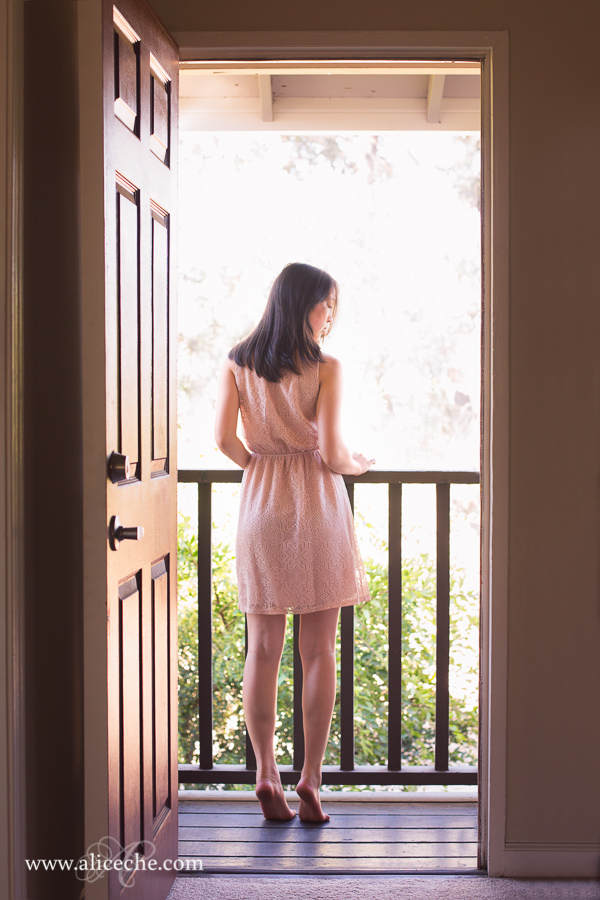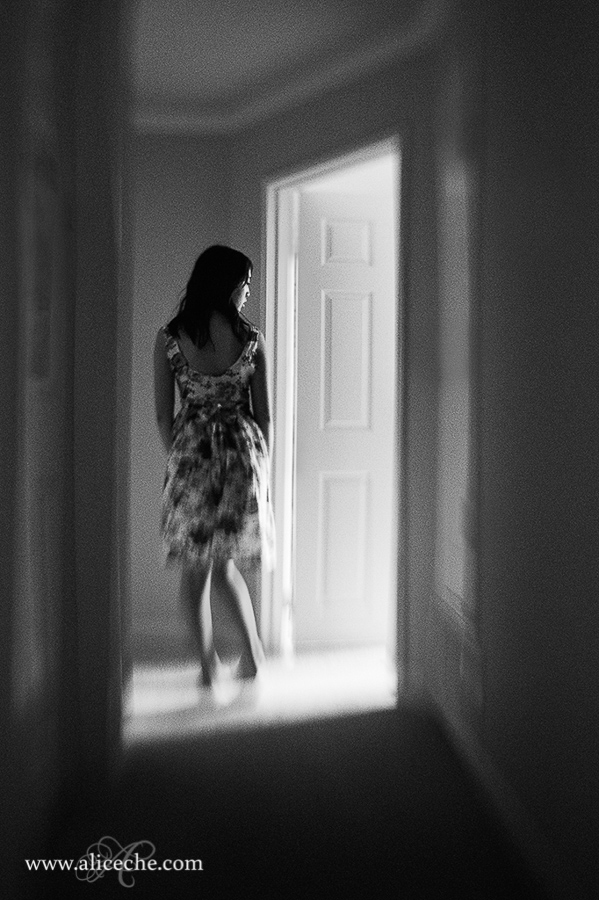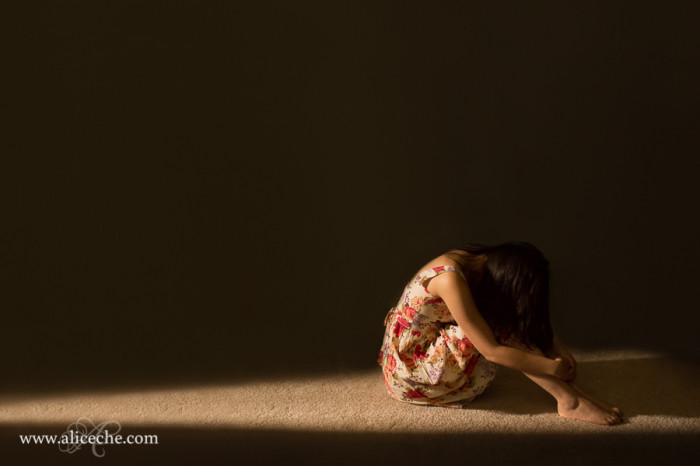Therapeutic Self Portraiture
Being big fans of self-portraiture, we are honored to present the following article written by Alice Che. Alice has found self-portraiture to be a therapeutic way to express emotions she is feeling at certain times in her life.
Finding Peace Through Self-Portraiture
by Alice Che
When I think about my favorite photographs I have taken, my self portraits tend to be the first to come to mind. I have to admit that part of the reason I started taking self portraits was because I wanted some nice pictures of myself! I also wanted to practice lighting: I lean towards introversion, so I tend to feel a little bit guilty asking friends and family to model for me. I ended up with quite a few photos that were perfectly reasonable portraits, but weren’t anything more than that. The lighting was fine (probably a little flat), my hair was nice, my makeup was done, I was smiling at the camera… but there was no emotional connection. There was nothing about them that made you stop and think or want to look at them again.
As I mentioned, I am a little bit introverted. I have a habit of keeping my emotions to myself and a select few close friends. I hate bothering people, so I tend to not say anything when I am upset or feeling down. My friend once jokingly said something about taking all of his emotions, squishing them into a teeny little ball and locking them away. And this, to some extent, is what I do. Except you can’t truly lock emotions away — they have a tendency to build up and result in an emotional meltdown. My photographs, and specifically many of my self portraits, are my way of opening myself up to people and preventing those meltdowns.

I am often uncomfortable putting my deepest emotions down into words, whether written or spoken: it is easier for me to show them through photographs — specifically self portraits. The first time I did this was almost two years ago now, when I was feeling down about just… everything in general. I was worried about getting into graduate school and what I was going to do with my life. I was also in the midst of ending a somewhat toxic relationship. I had major self confidence issues and was just having a really rough time when I came across this quote and fell in love with it. Without even realizing what I was doing, I decided I wanted to hand-letter it, take a picture, and share it on Facebook. Now, this might not be true for everyone, but I have to say that sharing the photo with my friends was part of the healing process for me. It was my way of sharing my emotions without having to explicitly state them. This is still one of my favorite photographs I have ever taken and I’m planning on printing it soon to hang up on my wall as a daily reminder that you can’t change the past, but you are in control of your future.
It wasn’t until this summer, however, when I stumbled across that photograph again while pulling together my portfolio, that I remembered how much better I had felt after taking that photo. There was something about the entire process of taking a photograph that expressed my emotions at the time — the uncertainty and melancholy that I was feeling with the underlying hope that I could turn things around — that just made me feel so much better. It helped me process my emotions more. I am the kind of person who needs to stop and spend some time thinking things through and truly figuring out how I feel. It was really rather fortunate timing, as I went through a rough patch just a few days later and immediately turned to self portraiture as an outlet for my feelings.

There are two different approaches I take when using self portraiture as therapy. Sometimes I brainstorm and come up with a list of words that I want the final photograph to embody. For the photo below, the words that I had jotted down were completely alone, moody, dark, hopeless, vulnerable. I was very deliberate with my choice of location, posing, light and processing to evoke the mood that I wanted. For example, I knew even before I started taking pictures that I wanted to convert into a strong black and white, so I chose a location that would give me dramatic lighting. Posing was also key. I have another photo from the same set where I am looking at the camera that comes off as a little aggressive, rather than lonely.
Other times I try not to overanalyze and I just go find some pretty light and start taking pictures. There is something about taking the time to slow down and pose in front of a camera that is incredibly calming for me. Honestly, even when I am not feeling down, it always brightens my day a little to take a self portrait. I love that I can take all the time I want to set my shot up perfectly and redo it until I get exactly what I want — even if I didn’t necessarily know what I wanted to start out with. Often, the photo that I end up with tells me a little more about how I am feeling.

Here are a few things that I have learned.
1. Don’t be afraid to take a LOT of photos! Seriously. I often take at least five to ten photos to get my final image. And that’s not even necessarily taking into account the ones I take to make sure the focus and composition is what I am looking for. Sometimes I even end up taking thirty before I end up with one that I consider a keeper.
2. If you don’t feel comfortable being in front of the camera, try looking away from your camera. I just looked through the photos in this post and realized I only have one photo where I am looking into the camera! Obviously you /can/ get a beautiful emotive photograph where you are looking at the camera: I just tend to be more comfortable using posing to get my message across. So if you feel a little bit awkward in front of the camera or feel that you can’t get your emotions across when you are looking at an inanimate object, try looking away.

3. Photoshop is your friend. I’m not telling you to completely rely on Photoshop: it is always easier to get everything right in camera. But I often think that as far as self portraits go, composition is even more of a struggle for me than focus! You aren’t looking through the viewfinder, so you often don’t realize that your head is just slightly chopped. Or I’ll find that I love my expression in one photo and my hand position in another.. and I’ll just decide I can composite them, rather than running back and forth a few more times. I have also done a /lot/ of cloning. Ten times out of ten, I will choose a location for the gorgeous light even if I know that I will need to declutter the background later in Photoshop.
4. Post processing is your friend! Therapeutic self portraits tend to be about a very strong emotion and the right post processing can really help emphasize that emotion. Convert to a strong black and white and add grain for a moody photo. Try a slightly matte feel and add a pastel fill layer for a softer emotion. Go even further and use your HSL sliders (or white balance or curves) to manipulate the colors of your photo. Play with textures too!

5. Your lens choice can make a huge difference in the final result. I turn to my Edge 80 a lot for self portraits because of the soft dreaminess that it can add to a photograph. I actually use the Sweet 35 quite a bit as well, though I have to make sure not to over-do the radial blur.
I know this won’t be for everyone, but I hope that the next time you are going through a rough patch, you will at least think about giving self portraiture a try! And I really truly hope that this will help some of you heal as much as it has helped me.
 Alice Che
Alice Che
Alice Che lives in the San Francisco Bay Area, where she works at Google as a Hardware Engineer by day. She shoots with a 5d Mark III and is slowly accumulating a collection of L glass. When she is not at work or playing with her camera, she loves to cook, bake and do all sorts of crafty things like calligraphy.
Tags: beautiful photographs, Inspiring Photography, personal photography project, Photo Projects, photography forum, Photography Forum for Women, photography inspiration, self portraits, the photographer within
Categorized in: Guest Bloggers, Portraits






18 Comments
Alice, thanks so much for putting this together for TPW! I have done two self-portrait based 365’s and I agree that there is such a therapeutic quality to self-portraits. I learned so much about photography, about lighting, and about my own self doing those projects.
Thanks Jes! I am so impressed with your two self portrait based 365s! I can’t imagine the dedication and creativity that takes!
Thank you so much for this. I am going through a rough patch myself right now and am inspired by your words! I think I’m going to work more self portraits into my 52 project this year. Beautiful work!
Oh Kathy, I’m so sorry to hear about your rough patch! I really hope that self portraits will help you heal. Glad I could be inspiring <3
Ooh, some of my fave here, and some I had not seen! I love the one of you lying on the bed! Great article. I need to practice this more.
Thanks Carrie! Looking forward to seeing yours! <3 <3
The queen of the self portraits! Alice always has amazing skills thanks for sharing this Alice!
Dina, that is so sweet! Thank you!
Your images are gorgeous! Love your use of light and the emotion in every single one 🙂
I wish I had the patience to get focusing right ..
Thank you Jess! I hope you give it a try! I swear it gets easier!
Alice, your work is beautiful and evocative. I love all of your tips and your bravery! As a fellow introvert, I know how hard it is to open yourself up, and you have touched a lot of us with this article. Thank you.
Aww, thank you Holly. You are such a sweetheart! <3
Beautiful shots, Alice.
Wow – really really stunning work. And so emotional – I was so moved! I can relate on so many levels.
gorgeous images! i’m inspired to do a selfie right now!
Totally needed this article! I love that quote. Very refreshing. I’m just starting to look into how to do self portraiture and these are great steps! Thank-you!
Alice you are just beautiful and I love all the gorgeous lighting you used.
These are so beautiful. I am obsessed with doing self portraits. I really enjoyed reading this post!